Pekka Buttler (Updated 11/2025)
NOTE PLEASE: This article has been superseded by a trio of articles covering each of the three lens mounts separately (and in greater detail). Please have a look at:
• Canon FL mount
• Canon FD mount
• Canon FDn mount
(this article has been retained for compatibility reasons)
See this posting for the rationale behind the change.
Introduction
This article is about the Canon FL-, FD and FDn -mounts. Due to the similarities of the three mounts, all will be covered in the same article.
The Canon FL/FD(n) -mount was not as long-lived as some of its contemporaries, but was nevertheless both influential and of significance to both historians and those among us who have an interest in using legacy lenses on their modern cameras.
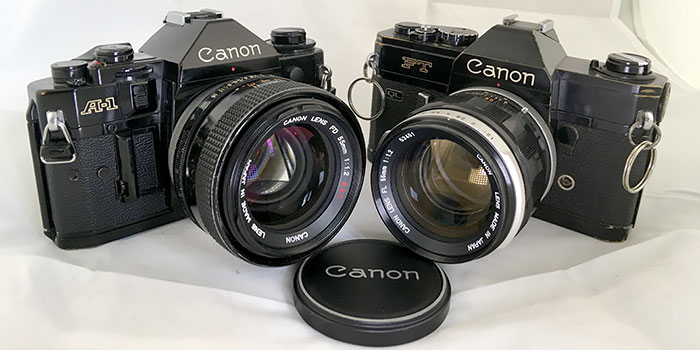
Right: Canon FT QL and Canon FL 55 mm f/1.2
Note, the classic “Canon” typography
Before going further, it is worthwhile to note that the FL/FD(n)-mount is one in a long lineup of Canon interchangeable lens mounts for SLR’s. A short genealogy of the Canon SLR mounts is:
Canon R 1959–1963
Canon FL 1964–1968
(Canon EX 1969–1972)
Canon FD 1971–1979
Canon FDn 1979–1990
Canon EF 1987–2020
Canon EF-S 2003–2020
Canon EF-M 2012–2020
Canon RF 2018–today
Also, it is important to note, that while only Canon made FL/FD-mount cameras, lenses for these mounts were made by several third-party lens manufacturers.
This article will first discuss the relationship between the FL and FD mounts, thereafter focusing on FD lenses and their iterations and ending with discussing the adaptability of FL and FD lenses
Canon FL, FD, FDn mount specifications
Mount type:
FL and FD: Breech lock (locking ring on lens)
FDn: Bayonet
Flange focal distance: 42 mm
Film format: 36mm x 24mm (‘Full frame’)
Mount communication:
FL: one lever for actuating aperture stop down at time of taking the shot (camera-to-lens)
FD & FDn: one lever for actuating aperture stop down at time of taking the shot (camera-to-lens); another lever to report aperture selected on lens (lens-to-camera)
Identifying the FL, FD and FDn mounts
Canon FL

Key characteristics of the mount of Canon FL lenses:
[1] Breech lock locking ring, rotates approximately 90 degrees (when not connected to a camera).
[2] Alignment pin.
[3] Stop-down lever.
Canon FD

Key characteristics of the mount of Canon FD lenses
[1] Breech-lock locking ring, rotates approximately 90 degrees (when not connected to a camera or adapter).
[2] Alignment pin.
[3] Stop-down lever.
[4] Aperture indicator lever.
Canon FDn
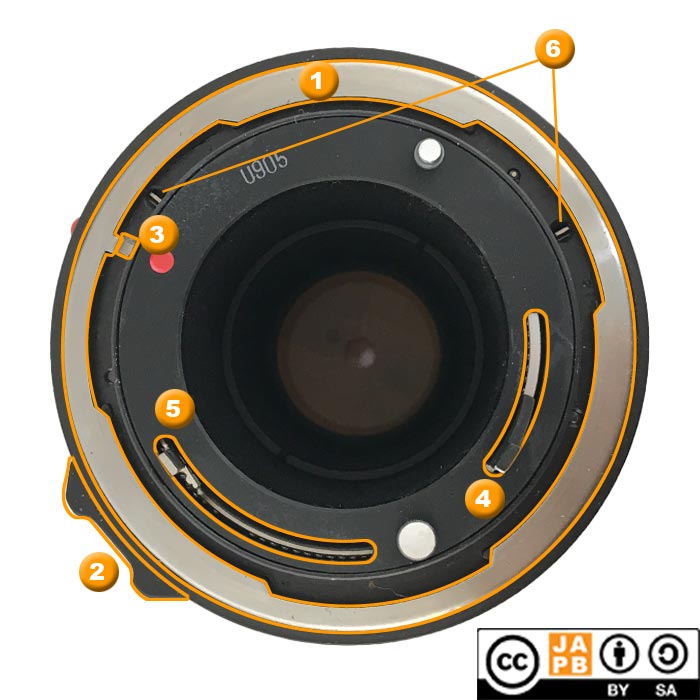
Key characteristics of the mount of Canon FDn lenses
[1] Female bayonet mount with three openings.
[2] Lens release button (pops out when lens locks on body/adapter).
[3] Alignment pin.
[4] Stop-down lever.
[5] Aperture indicator lever.
[6] Bayonet activation pins (bayonet is locked until body’s or adapter’s prongs or lens cap depresses these).
The Canon FL mount
Canon introduced the FL mount in 1964 and it offered some key improvements over the previous R/Canomatic mount – especially that lens apertures returned to wide open automatically. Even so, the FL lenses (and cameras) were still designed towards (manual) stop-down metering.
Canon FL lenses were based on the idea that composing and metering is always done with a fully-open diaphragm, which is closed down to the aperture desired by the photographer only when a) the photographer wants to take a metering reading; b) the shutter button is pressed for taking a shot or c) when the photographer wants to assess depth-of-field.
Compared to later FD and FDn lenses, FL lenses did not enable the camera to know what value the photographer had set the aperture for, meaning that metering could not be automatic. Instead, the photographer had to manually stop down the lens in order to meter (typically referred to as ‘stop-down-metering’). Secondly, FL lenses did in no way support the idea that a camera could decide the suitable aperture on the photographer’s behalf.
Physically, the central difference is in that whereas FL lenses only had one lever (which the camera activated to stop down the aperture for taking a picture), FD lenses had two levers – the first of which had the same function as that of FL lenses (but allowed more precise stopping down), with the second being used by the body for reading and commanding the lens aperture. See pictures below.
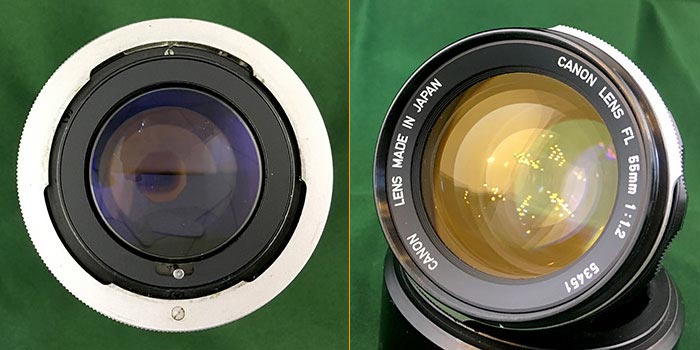
Notice the stop-down -lever being the lens mount’s only control interface.
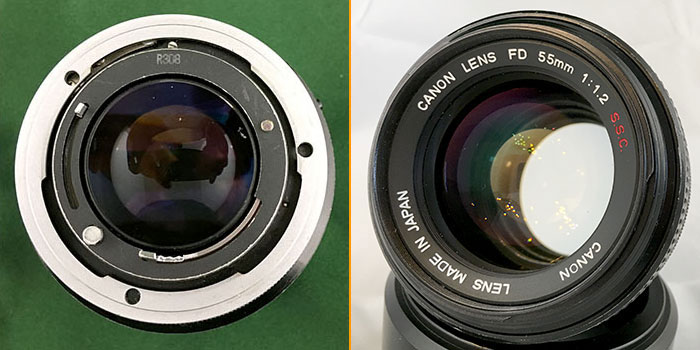
Notice the changed stop-down lever as well as the second lever for reading/setting lens aperture on the left of the rear lens element.
FL and FD lenses are thereby easy to distinguish. Not only is it typically clearly indicated on the lens’ name ring which family the lens belongs to (at least for Canon lenses), the number and location of levers on the lens mount is a clear differentiator.
FL/FD/FDn-lens compatibility
Most importantly, the actual breech-lock mount of the lens was not changed going from FL to FD. Not only did this mean that FL lenses could be used on FD bodies just as they had been used on FL bodies (using stop-down -metering). This greatly eased the transition into FD-cameras for photographers who already had an investment into FL-lenses.
From the viewpoint of someone using FL or FD lenses adapted on mirrorless digital cameras, FL lenses work just as well as FD lenses (assuming that the FL lens does not have ‘the bulge‘) and do so using the same adapter (What is ‘the bulge’? Read more here.).
In my opinion, ergonomically FL lenses are more user-friendly, as FL lenses had their aperture control ring on the front of the lens, thereby lessening the risk of the photographer accidentally turning the wrong ring.
Naturally, FL-lenses typically lack the more modern coatings and modern designs of their successors, but many feel that adds to their charm.
Using FL lenses
As noted, the aperture control ring of FL lenses was situated at the front of the lenses, an uncommon arrangement from today’s point of view, but very much typical for that day and age.
FL lenses were designed so that users could turn the aperture ring without it directly modifying the actual aperture, thus aiding composition and focusing. Thereafter the user would stop down to meter, and finally take the shot. While (to my knowledge) all Canon FL bodies enabled stopping down by pressing a lever on the camera body, they also had an arrangement for effecting the same result on the lens.
In fact, even in the short time the FL range was being developed, Canon used at least two different methods on FL lenses:
• Canon FL lenses started with a method that uses a second aperture ring to switch between fully open and stopped down modes (very much like an aperture preset ring, albeit with only two modes: fully open and stopped down to preset).
• Later (from ≈1965 onward) Canon FL lenses switched to using a ring to switch between auto and manual aperture modes (very much like many M42 lenses).
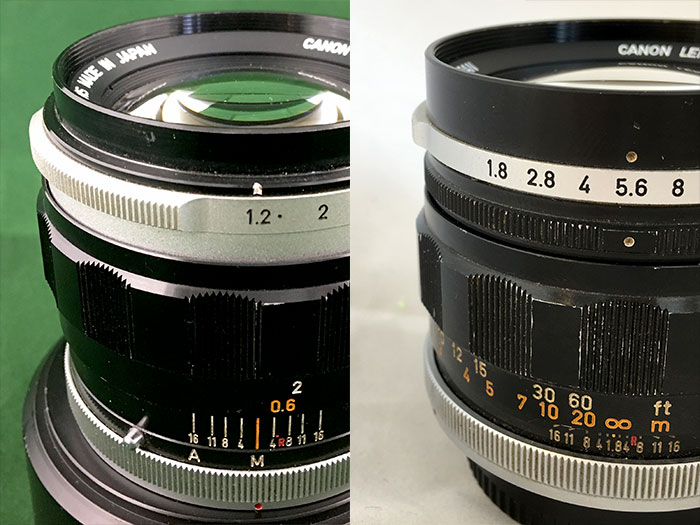
Notice:
– the A/M control ring on the left (below focusing ring)
– the close-down ring on the right (between aperture control and focusing rings.
The Canon FD mount
By the late 60s, Canon had become painfully aware of the shortcomings of the FL mount, especially with regards to enabling exposure automation. While Canon has often made bad bets and even outright mistakes, Canon has also been very good at learning from those.
It is therefore not surprising that The Canon FD mount was designed with three central considerations:
- Backwards compatibility, allowing the use of Canon FL lenses on Canon FD bodies
- Allowing the body to decide how far to stop down the lens’ aperture (thereby enabling shutter priority automatic exposure)
- Facilitating the camera body’s ability to ‘read’ what aperture the photographer had set on the lens (hence enabling aperture priority automatic exposure).
In many ways these considerations contributed to making the mount reasonably future-proof, considering that they enabled shooting modes which (at the time of their launch) were not yet available in Canon’s bodies (nor any other).
In many ways the Canon FD mount was instrumental to paving Canon’s way to prominence during the 1970’s and 80’s. That is not to say that Canon outpaced all its rivals during that time (indeed some other Japanese camera makers kept up), but it definitely put Canon into an enviable position going forward.
The strength of the Canon FD system was a combination of Canon’s ingenuity in developing camera bodies, combined with Canon’s world-class optics. Indeed, the Canon FD system was host to some lenses still memorable and highly sought-after today.
Admittedly, a system camera is more than its repertoire of lenses, but given this website’s area of interest (and the fact that legacy lenses remain more useful than, say, legacy speedlights), the focus here will be on lenses. And there were many of those…
Not only did Canon themselves manufacture more than 130 lenses (including variations) for the FD system – ranging from 7,5 mm fisheye lenses to 800 mm supertele’s and some absolutely crazy catadioptric ultra-tele lenses – but various third-party manufacturers contributed by roughly 300 further lenses (including variations). The prodigious catalog of lenses available – for every use and for every pocket – both helped draw photographers into the system and keep them there.
Simultaneously, the era of Canon FD coincided with an time during which three significant trends affected the photographic industry, while a fourth (the advent of autofocus) effectively ended the age of Canon FD. Nevertheless, the first three – the proliferation of zoom lenses, the increased use of plastics and increased in-body automation – each made their impact felt on the Canon FD lineup.
Prelude: Chrome nose lenses
When Canon introduced the FD mount in 1971, they initially introduced a bunch of lenses characterised by having a chromed bayonet arrangement at the front for mounting lens hoods 1. This chromed front (colloquially referred to as ‘chrome nose’) was based on a chromed bayonet being less likely to be scuffed and marked by the use of lens hoods.
Chrome nose Canon FD lenses are a bit special, because Canon clearly pulled out all the stops in order to construct some of the most fantastically solid lenses ever. Very typically Canon chrome nose lenses are significantly heavier that the FL lenses they replaced while also being a lot heavier than the (often otherwise identical Canon FD (black nose) lenses that replaced them. Some examples below:
| Canon FL (last version) | Canon FD ‘chrome nose’ | Canon FD earliest ‘blacknose’ | |
| Canon 28 mm f/3.5 | 240 g | 290 g | 250 g |
| Canon 35 mm f/3.5 | 270 g | 340 g | 236 g |
| Canon 50 mm f/1.4 | 340 g | 370 g | 350 g |
| Canon 135 mm f/3.5 | 434 g | 510 g | 465 g |
I have no detailed information, but it almost seems as if the Chrome nose lenses used denser metals than any other Canon lenses before or after.

Trend 1: The proliferation of zooms
The Canon FL lens lineup can be characterised by two traits: Firstly, few third-party manufacturers entered the market and only a handful of third-party lenses are available for the FL mount (and all those were tele lenses). Secondly, through the relative absence of zoom lenses, as only three models were ever produced2.
Going forward into the Canon FD age, both these changed, and the relative share of zoom lenses virtually exploded, until almost half of all lenses available for the FD (and FDn) mount were zoom lenses3. This trend further coincided with a beginning shift in the perception towards zoom lenses: no longer were zoom lenses uniformly considered to have bad image quality and to be purely for amateurs, instead major camera manufacturers, spearheaded by Canon and some others, started developing zoom lenses which even pro’s could accept to work with. In Canon’s case, this was indicated by the increasing number of zoom lenses Canon designated with their L (luxury) designator.
Trend 2: The increased use of plastics
Canon was by no means alone or ahead in the increase of using plastics in lenses (and other equipment), but with Canon, the trend was unusually visible due to the otherwise stable product lineup.
And before you get the wrong impression, I do not categorically condemn plastics. Plastics have many advantages: They are cheaper to manufacture and machine, they are lighter, and they can be more thermally stable than metals. On the other hand, there are clear indicators of lens manufacturers having used plastics in situations where metals and their higher strength and lesser tendency to break or abrade would have been called for. Therefore, as a personal opinion, while not being per se opposed to plastics, I do have more trust in a metal lens’ ability to work and be serviceable 50 (or 100) years after manufacture than a similar lens made using plastics.
The following picture (portraying three out of four variants of the FD 135/3.5) is a perfect illustration:
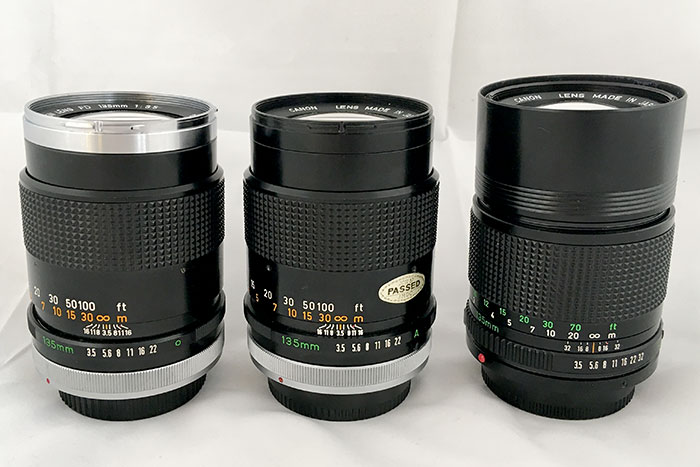
Canon FD 135 mm f/3.5 “chrome nose” (1970, 510 grams)
Canon FD 135 mm f/3.5 S.C. (I) (1973, 465 grams)
Canon new FD 135 mm f/3.5 (1979, 310 grams)
(Missing in picture: Canon FD 135 mm f/3.5 S.C. (II) (1976, 385 grams)
Trend 3: Increased automation
While the Canon FL mount had its origins in the age of fully manual metering, the impetus behind a lens mount which would allow the camera to both read and direct the lens’ aperture was to enable increased automation. In one sense, the Canon FD line was birthed to increase automation. And, boy, did it do that.
The 1970’s and 1980’s were two decades of profound change for the SLR industry. From having been the preserve of professionals and serious enthusiasts (people who did not mind a learning curve), SLR’s became the mainstream camera for all those who wanted to have (or be seen with) a serious camera.
But the hoi polloi could not really be bothered to learn how to expose their pictures manually. The idea of having to set both aperture and shutter speed to reflect light conditions for every shot was anathema to these users – most of whom had gotten used to cameras with lighting presets for ‘sunny’, ‘cloudy’ and ‘lightbulb’. In order for SLR’s to appeal to these masses, nailing exposure had to be automated. Hence, shutter priority (user sets shutter speed, camera compensates with aperture) and aperture priority (user sets aperture, camera compensates with shutter speed) became mainstream features.
And when it became apparent to Canon (and its competitors), that many new SLR owners could not even be bothered to learn about aperture priority and shutter priority (and their limitations), program auto (the ancestor of full auto) was born.
Keep in mind, that while all these shooting modes depended on body and lens being able to communicate (for aperture priority the body needed to read the aperture, for shutter priority the body needed to be able to set the aperture), they de-facto also necessitated a thorough computerisation of the camera body. Not only did the body need to have a chip to calculate suitable aperture-shutter speed combinations in light of (pun intended) the metering result, but that chip needed to be able to precisely direct shutter and aperture. Therefore, the traditionally mechanical control linkages had to – at least partly – be replaced by electronic counterparts. And while many functional camera bodies from this era still exist, many have also fallen prey to decaying electronics.
As with other camera manufacturers, for the body to be free to direct the lens’ aperture, the lens aperture first had to be set to the minimum aperture (whether f/16, f/22 or f/32). While some (e.g. Nikon, Minolta) merely made do with minimum aperture, Canon (and e.g. Konica) created a dedicated position to set the aperture ring to for automatic aperture4.
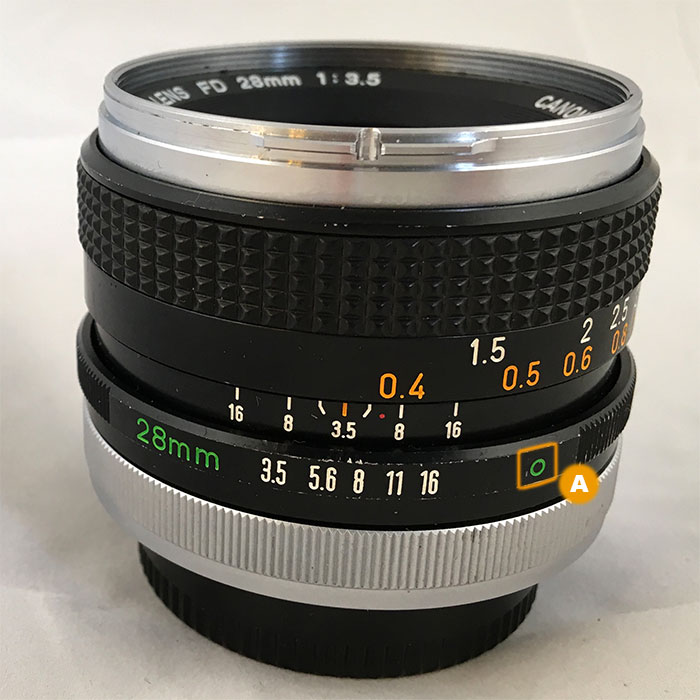
[A] when the aperture ring is rotated past 16 into the position designated by the green ball, the lens is in auto-aperture mode.
Again, Canon was being prescient, as the functionality was available on even the earliest FD lenses – way in advance of a camera body which could make use of the feature. Subsequently, as use of the auto setting on lenses became more prevalent, Canon added a locking mechanism for the auto setting so that a user would not inadvertently move the aperture ring out of auto.
FDn (new FD)
Given the two-decade lifespan of the FD mount, it is not entirely surprising that Canon during that period developed the mount (and lenses) further. Besides typical design iterations on specific lenses (which typically brought weight savings and more modern coatings, sometimes even changes to the underlying design), there are two visible shifts in the lens lineup – one major and another cosmetic:

Right: Canon FDn 50 mm f/1.4
Note: FD lenses had a silver coloured ring at mount-end (the locking ring for the breech-lock mount), which FDn lenses (obviously) lack. FDn lenses on the other hand have the red ball indicating “up” when entering lens into camera.
The major shift is the change of mounting system while keeping full compatibility. In 1979 Canon suddenly changed the operating principle of the the FD mount from being a breech-lock to being a bayonet, and did so without this having any effect on the camera bodies. Instead of aligning a lens and turning the locking ring (breech-lock -principle), you now aligned the lens and twisted the entire lens (bayonet-principle). And this was accomplished while retaining full compatibility. Not only were you able to use new FD (abbreviated FDn) lenses on (old) FD bodies and vice versa, you could even mount FDn lenses on FL bodies (naturally, without all the advanced features).
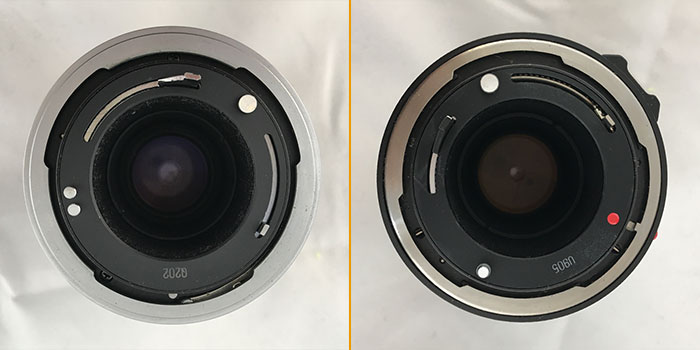
When comparing FD and FDn lenses it seems the entire mount has rotated 45 degrees counter-clockwise. This is to compensate for the rotation necessary for the bayonet-mount twist-and-lock-motion. On right-hand picture, note bayonet release button at 1:30 o’clock.
Remember: at JAPB 6 o’clock is always where the lens’ upside is.
Side note: I have always (personal taste) been somewhat dubious about the munificence of breech-locks as lens mounts. While I understand that breech-lock mounts theoretically minimise wear and (when well implemented) still enable a mounting system which secures a lens without any risk of play, my personal experience with breech-lock mounts does not support this.
In fact, the only two times I’ve ever dropped a lens off a camera have happened with breech-lock mounts (once I managed to catch the lens, the other was a write-off). Due to confirmation bias, I therefore see Canon’s (and others’5) move away from breech-lock mounts as testament to that breech-lock mounts – while optimal in theory – are hard to make work.
In tandem with the introduction of the FDn mount, Canon started a redesign of the entire lineup of FD lenses, introducing a total of 29 FDn lenses in 1979 and another 11 the year after. FDn lenses (compared to those which they replaced) were uniformly lighter and although they no longer had the S.S.C. markings (indicating quality of coating), their coatings were of at least similar standard than that of their predecessors.
Adapting Canon FL, FD and FDn lenses
For those intending to adapt legacy lenses on their modern mirrorless, there are a lot of good news here. If you’re relatively new to adapting legacy lenses, you might want to have a look at this article on the practicalities of adapting legacy lenses.
Firstly, no matter whether your mILC of choice is full-frame, APS-C or MFT, there are adapters readily available (but … see below). Also, for those who use legacy lenses on smaller-than full-frame bodies, there are speedboosters available.
Secondly, Canon FD (and FL) lenses offer a very attractive alternative for building a set of legacy lenses: the roster of lenses is wide and covers all focal lengths and functions; the quality of Canon glass has never been an issue; and (while certainly not as cheap as 5 years ago) Canon FD glass is quite cost-effective.
Thirdly, Canon has been able to maintain a relatively high level of optical uniformity, leading to that Canon FD glass gives semi-serious videographers an cost-effective alternative for building up a set of primes (after cine-modding), as long as the set is built using lenses from the same series (e.g. FDn).
Fourthly, the entire lineup of lenses, from FL to FDn can be adapted using the one and same adapter, whether a dumb adapter or a focal reducer (see caveat below).
The four-ring-problem
But, there is a downside, in that Canon FD lenses are somewhat finicky to use. Due to the way the FD mount (in all variations) works, adapters always need to have a control ring, which the photographer uses to allow the aperture to reflect those values set on the aperture ring. At a minimum this adds one more ring to the arsenal of rings, that the photographer will need to manipulate.
Moreover, for those who like to be able to use their lenses without their eye leaving the viewfinder, this can lead to confusion – especially on FD (not FDn) lenses, as this results in three rings very close together at the camera-body end of the adapted lens: The aperture close-down ring on the adapter; the breech-lock tightening ring on the lens; and the aperture ring. In the absolute worst-case scenario, the photographer is handling the wrong ring and notices their error only when the lens falls of the adapter.
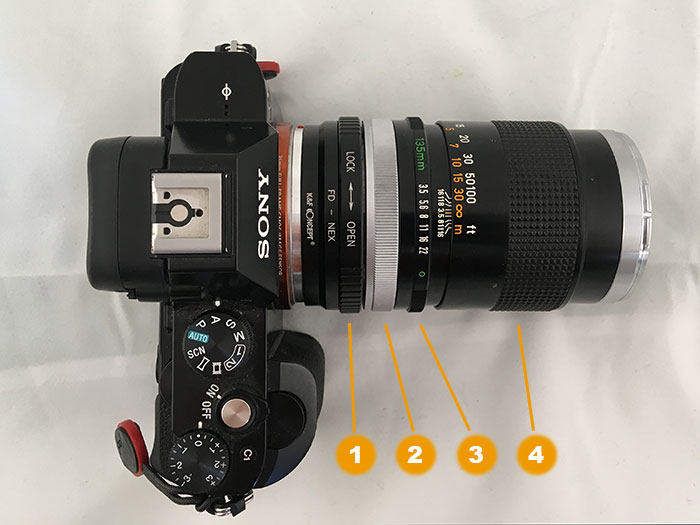
[1] Activation ring for aperture control
[2] Locking ring for breech-lock mount
[3] Aperture ring
[4] Focus ring
Note, that especially the first three rings are very close together.
In this respect FL lenses are less problematic because their aperture control ring is at the lens front, thereby lessening the risk of confusion, while FDn -lenses do away with the breech-lock tightening ring altogether.
On the other hand, some FL lenses have ‘the bulge‘ and will not work with all adapters because of not entirely uniform depth (see pic below). In the case of the FL 35 mm f/2.5 one of my FD->NEX adapters (K&F) fits (albeit barely), whereas others do not. Some legacy lens aficionados have circumvented the issue by removing the aperture engagement pin from their Canon FD adapters (thereby basically making them dedicated Canon FL and Canon R adapters). See more in this JAPB article.

Right: Canon FL 55 mm f/1.2
Note that the mount of the 35/2.5 bulges out. Depending on your adapter, it therefore might not fit.
Footnotes:
- To my knowledge, the following FD lenses exist as chrome nose: 24/2.8; 28/3.5; 35/2; 35/3.5; 50/1.4; 50/1.8; 55/1.2; 100/2.8; 135/3.5. ↩︎
- Canon camera museum, FL lenses ↩︎
- All photo lenses, search by mount ↩︎
- I might be mistaken, but I think that the auto-position of the aperture ring is superfluous in the sense, that it is no different in function from minimum aperture. That would mean it is really just a usability feature. ↩︎
- The Canon FD mount was (to my knowledge) the second to last breech-lock mount, with only the Contax G mount surviving longer than it. ↩︎